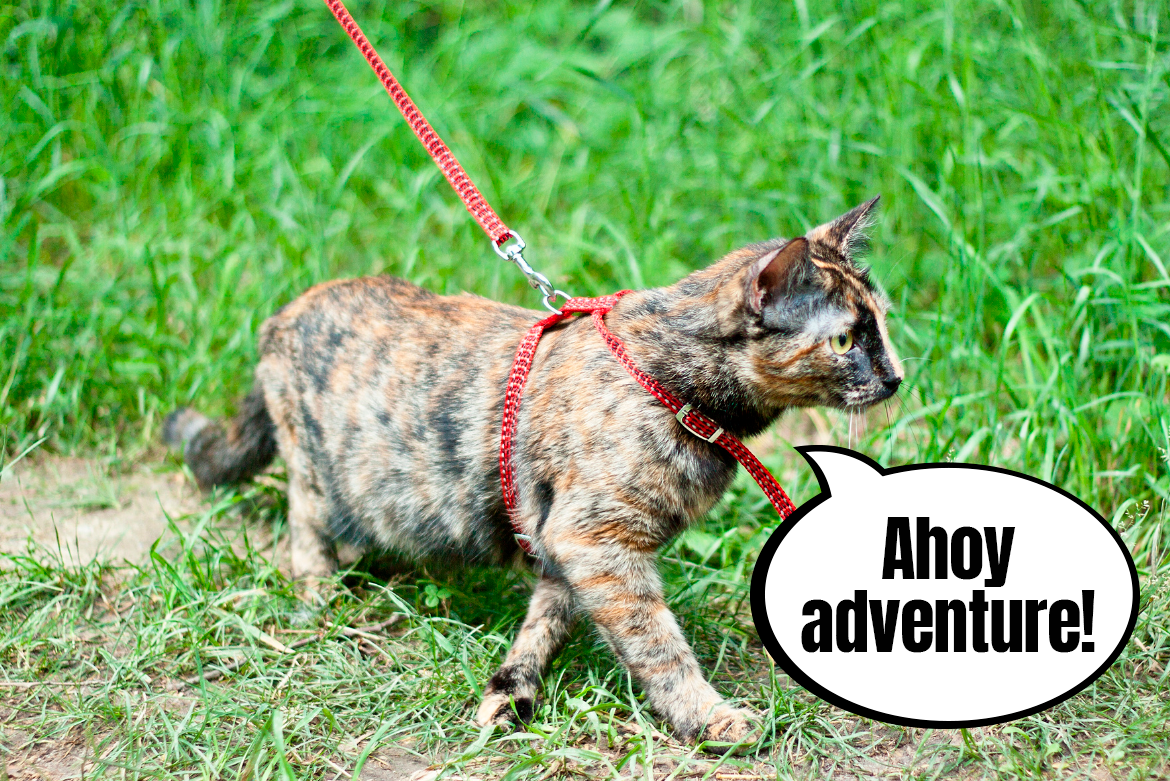Is going out for a walk reserved for dogs and their caretakers? Well, not exactly, and seeing a cat on a leash is no longer surprising. Today’s article will be devoted to taking cats for a walk, and the inspiration for this topic was the amateurs of travels, Yuma and Laura (@yuma_and_laura) and the team from Cat Effect (@cat_effect) – their relations from smaller and larger trips you can – just like us – follow on Instagram! So how do you prepare for a walk with a furry? Except for the camera, you will certainly need the right equipment. See what this word means here. 😼
Before we talk to the equipment
Think about going for a walk with your cat like a great adventure, but before you start to explore the big world, you will need to prepare properly, and we don’t mean just the right equipment for the occasion. It should be noted that not every cat will be suitable for walks. More skittish individuals who become stressed seeing other animals or strangers, may not be able to tolerate such an exit at all, and consequently may develop one of the post-traumatic stress disorder syndromes. Therefore, nothing by force! The walks will be suitable for curious and quick-witted furries with an exploration gene as strong as Jason Lewis or Paul Salopek! It’s worth remembering, however, that cats, as territorial animals, often need much more time to get used to new terrain than, for example, dogs. If it turns out that after one or two attempts, the walks are not for your cat, let it explore what he likes the best in the comfort of four walls (e.g. dish of the day in a bowl or new recesses on the couch).
💉 Important
A cat leaving the house should be dewormed more often than the one that doesn’t use the charms of freedom. A furry that takes walks should also be vaccinated regularly, not only with the basic feline vaccine (cat runny nose and panleukopenia), but also for diseases such as leukemia and rabies. You also need to regularly protect your pet from fleas and ticks.
🌾 Hint
For your first cat walk, choose a quiet and secluded place so as not to frighten the cat. Avoid bushes, tall grasses and other thickets – there’s no fun in disentangling a cat from them!
Cat carrier
A suitable carrier is a must have for a cat caretaker. Not always the open air we choose is a backyard park or garden. It happens – especially if you live in the city – that taking your pet for a walk requires a longer or shorter ride to another part of the city, to a place that’s suitable for a cat’s walk. You probably already have a carrier for your pet – many trips to the vet would not be possible without it! You can, of course, use that one or think about a special model that resembles a backpack with a window, in which a trip to a destination will become an adventure for your pet, as he will be able to observe the surroundings and at the same time safely reach the destination. Below you will find one of these types of transporters – they are practical and look designer! And you, having such a backpack with a cat on board, will surely make a sensation in the city.
Your cat doesn’t have a transporter yet? Read this article:
Leash and harness
These are other accessories that you will need to stock up on before the first walk with your cat. Letting go of the cat, even if you are just the two of you in a secluded place, is an idea as crazy as shearing a sphinx! Remember that a cat outside may behave completely differently than at home (e.g. it may start running away even when it sees you). That’s why the leash and harness will ensure a minimum of safety and guarantee that the cat will not get lost. 2-in-1 products will work well, where in addition to the leash, the set will also include harnesses made of comfortable, breathable material, preferably with additional reflectors (thanks to which the pet will also be visible at dusk). This solution is safer than using an ordinary collar (it may slip off during the walk), to which you attach a leash. The market offers much more interesting and safer solutions for the furries. Take a look at these example:
Important:
A cat to walk on a leash will have to learn first. To reduce his stress related to learning, divide the training into a few stages. Start by putting a harness at home for 10-30 minutes every day (for a week or two before the first walk). When your pet accepts the harness and feels comfortable in it, attach a leash to the harness and observe your pet. Doesn’t look stressed out and moves freely? Great, now it’s time for the dress rehearsal outdoors! 😻
Cat ID
If your pet isn’t chipped, don’t leave the house without the tag attached to the harness or collar. Various situations can happen while walking, and as the old adage says, forewarned is forearmed! So it’s better to be safe than sorry and put basic contact details on the card (phone number, optional address) so that in the event of a cat missing, the person who finds it can return the pet to the owner. It’s a bit of an old school way, but if for some reason you can’t chip your pet, it’s better than nothing.
Snacks
Don’t even think that you will skip this important element of your equipment! While exploring new areas, your fluffy friend will get hungry quickly. Activity on the fresh air and a huge dose of excitement improve the appetite! Don’t let the cat associate your outdoor adventure with hunger. In addition, you can also use a snack as a form of reward for the cat’s courage and bravely facing the new situation in which the pet has found himself – show it, that there is no risk, no gain! 😼
How is it with you, fabCat? Do you take your cat for walks or do you both limit yourself to going to the balcony at most? We are very curious about your experiences! Let us know in the comment.
Read also:




